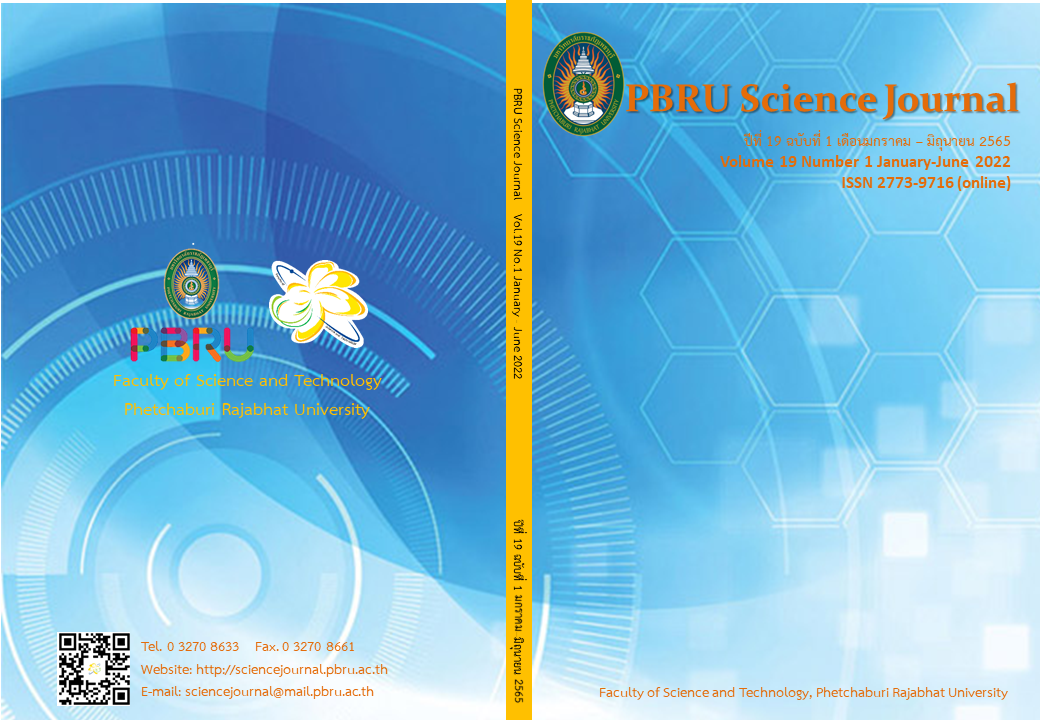สารกลุ่มเบนโซฟีโนนและกลุ่มแซนโทนที่แยกได้จากผลชะมวงสุกเป็นตัวยับยั้งเอนไซม์แอลฟา-กลูโคซิเดสที่มีประสิทธิภาพ
Main Article Content
บทคัดย่อ
การศึกษาพฤกษเคมีจากผลสุกของชะมวง (Garcinia cowa Roxb. ex DC.) สามารถแยกและระบุสารกลุ่มเบนโซฟีโนน 2 ตัว คือ garcicowin B (1) และ oblongifolin C (2) และสารกลุ่มแซนโทน 3 ตัว คือ brasixanthone B (3), 9-hydroxycalabaxanthone (4) และ 3-O-methylmangostenone D (5) โครงสร้างของสารที่เคยมีการรายงานแล้วที่แยกได้ทั้งห้าตัวนี้ถูกหาได้โดยวิธีทางสเปกโตรสโคปี (UV, IR และ 1H-NMR) และเปรียบเทียบกับข้อมูลที่เคยมีการรายงานมาแล้ว สารทั้งหมดที่แยกได้ถูกนำไปทดสอบฤทธิ์ยับยั้งเอนไซม์แอลฟา-กลูโคซิเดส ผลพบว่าสาร 4 และ 5 แสดงฤทธิ์ยับยั้งเอนไซม์แอลฟา-กลูโคซิเดสด้วยค่า IC50 เท่ากับ 63.41 ± 1.26 และ 87.16 ± 0.35 ไมโครกรัม/มิลลิลิตร ตามลำดับ ผลจากการศึกษานำไปสู่การใช้ประโยชน์สำหรับงานวิจัยด้านเคมีผลิตภัณฑ์ธรรมชาติต่อไป
Article Details

อนุญาตภายใต้เงื่อนไข Creative Commons Attribution-NonCommercial-NoDerivatives 4.0 International License.
บทความที่ได้รับการตีพิมพ์เป็นลิขสิทธิ์ของ PBRU Science Journal
เอกสารอ้างอิง
อรรถเกียรติ กาญจนพิบูลย์วงศ์. ภาณุวัฒน์ คำวังสง่า และสุธิดา แก้วทา. 2563. รายงาน สถานการณ์โรค NCDs เบาหวาน ความดันโลหิตสูงและปัจจัยเสี่ยงที่เกี่ยวข้อง พ.ศ.2562. กรุงเทพมหานคร: กองโรคไม่ติดต่อ กรมควบคุมโรค กระทรวงสาธารณสุข.
Johnston, P.S., Coniff, R.F., Hoogwerf, B.J., Santiago, J.V. and Pi-Sunyer, F.X.A. 1994. Effects of the carbohydrase inhibitor miglitol in sulfonylurea-treated NIDDM Patients. Diabets Care. 17: 20-29.
Sriyatep, T., Siridechakorn, I., Maneerat, W., Pansanit, A., Ritthiwigrom, T., And ersen, R. J. and Laphookhieo, S. 2015. Bioactive prenylated xanthones from the young fruits and flowers of Garcinia cowa. Journal of Natural Products. 78: 265-271.
Xu, G., Kan, W. L. T., Zhou, Y., Song, J-Z., Han, Q-B., Qiao, C-F., Cho, C-H., Rudd, J. A., Lin, G., and Xu, H-X. 2010. Cytotoxic acylphloroglucinol derivatives from the twigs of Garcinia cowa. Journal of Natural Products. 73: 104-108.
Hamed, W., Brajeul, S., Mahuteau-Betzer, F., Thoison, O., Mons, S., Delpech, B., Nguyen, V.H., Sevent, T. and Marazano, C. 2006. Oblongifolins A-D, polyprenylated benzoyl phloroglucinol derivatives from Garcinia Oblongifolia. Journal of Natural Products. 69: 774-777.
Ito, C., Itoigawa, M., Mishina, Y., Filho, V. C., Mukainaka, T., Tokuda, H., Nishino, H., and Furukawa, H. 2002. Chemical Constituents of Calophyllum brasiliensis: Structure elucidation of seven new xanthones and their cancer chemopreventive activity. Journal of Natural Products. 65: 267-272.
Ee, G. C. L., Daud, S., Taufiq-Yap, Y. H., Ismail, N. H. and Rahmani, M. 2006. Xanthones from Garcinia mangostana (Guttiferae). Natural Product Research. 12: 1067-1073.
Nguyen, H. D., Trinh, B. T. D., Nguyen, N. K., Dang, S. V., Pham, H. D. and Nguyen, L-H. D. 2011. Xanthones from the twigs of Cratoxylum cochinchinense. Phytochemistry Lett. 4: 48-51.
Shai, L.J., Magano, S.R., Lebelo, S.L. and Mogale, A.M. 2011. Inhibitory effects of five medicinal plants on rat alpha-glucosidase: Comparison with their effects on yeast alpha-glucosidase. Journal of Medicinal Plant Res. 5: 2863–2867.

